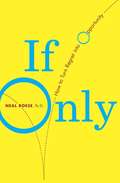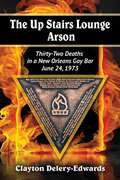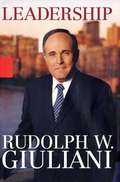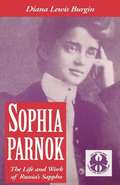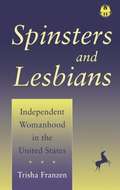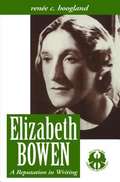- Table View
- List View
Louise Brooks
by Barry ParisLouise Brooks left Wichita, Kansas, for New York City at age fifteen and lived the kind of life of which legends are made. From her beginnings as a dancer to her years in Hollywood, Berlin, and beyond, she was hailed and reviled as a new type of woman: independent, intellectually daring, and sexually free. In this widely acclaimed, first and only comprehensive biography, Barry Paris traces Brooks's trajectory from her childhood through her fall into obscurity and subsequent "resurrection" as a brilliant writer and enduring film icon.
Robin and Ruby
by K. M. SoehnleinIn his award-winning bestseller The World of Normal Boys, K.M. Soehnlein introduced readers to the richly compelling voice of teenager Robin MacKenzie. In Robin and Ruby, he revisits Robin and his younger sister, masterfully depicting the turbulence of the mid-1980s--and that fleeting time between youth and adulthood, when everything we will become can be shaped by one unforgettable weekend. At twenty-years-old, Robin MacKenzie is waiting for his life to start. Waiting until his summer working at a Philly restaurant is over and he's back with his boyfriend Peter. . . until the spring semester when he'll travel to London for an acting program. . . until the moment when the confidence he fakes starts to feel real. Then, one hot June weekend, Robin gets dumped by his boyfriend and quickly hits the road with his best friend George to find his teenaged sister, Ruby, who's vanished from a party at the Jersey Shore. For years, his friendship with George has been the most solid thing in Robin's life. But lately there are glimpses of another George, someone Robin barely knows and can no longer take for granted. Ruby is on an adventure of her own, dressing in black, declaring herself an atheist, pulling away from the boyfriend she doesn't love--not the way she loves the bands whose fractured songs are the soundtrack to her life. Then a chance encounter puts Ruby in pursuit of a seductive but troubled boy who might be the key to her happiness, or a disaster waiting to happen. As their paths converge, Robin and Ruby confront the sadness of their shared past and rebuild the bonds that still run deep. In prose that is lyrical, compulsively readable, and exquisitely honest, K.M. Soehnlein brilliantly captures a family redefining itself and explores those moments common to us all--when freedom bumps up against responsibility, when sex blurs the line between friendship and love, and when what you stand for becomes more important than who you were raised to be.
1932: The Rise of Hitler and FDR--Two Tales of Politics, Betrayal, and Unlikely Destiny
by David PietruszaTwo Depression-battered nations confronted destiny in 1932, going to the polls in their own way to anoint new leaders, to rescue their people from starvation and hopelessness. America would elect a Congress and a president ebullient aristocrat Franklin Roosevelt or tarnished Wonder Boy Herbert Hoover. Decadent, divided Weimar Germany faced two rounds of bloody Reichstag elections and two presidential contests doddering reactionary Paul von Hindenburg against rising radical hate-monger Adolf Hitler. The outcome seemed foreordained unstoppable forces advancing upon crumbled, disoriented societies. A merciless Great Depression brought greater perhaps hopeful, perhaps deadly transformation: FDR s New Deal and Hitler s Third Reich. But neither outcome was inevitable. Readers enter the fray through David Pietrusza s page-turning account: Roosevelt s fellow Democrats may yet halt him at a deadlocked convention. 1928 s Democratic nominee, Al Smith, harbors a grudge against his one-time protege. Press baron William Randolph Hearst lays his own plans to block Roosevelt s ascent to the White House. FDR s politically-inspired juggling of a New York City scandal threatens his juggernaut. In Germany, the Nazis surge at the polls but twice fall short of Reichstag majorities. Hitler, tasting power after a lifetime of failure and obscurity, falls to Hindenburg for the presidency also twice within the year. Cabals and counter-cabals plot. Secrets of love and suicide haunt Hitler. Yet guile and ambition may yet still prevail. 1932 s breathtaking narrative covers two epic stories that possess haunting parallels to today s crisis-filled vortex. It is an all-too-human tale of scapegoats and panaceas, class warfare and racial politics, of a seemingly bottomless depression, of massive unemployment and hardship, of unprecedented public works/infrastructure programs, of business stimulus programs and damaging allegations of political cronyism, of waves of bank failures and of mortgages foreclosed, of Washington bonus marches and Berlin street fights, of once-solid financial empires collapsing seemingly overnight, of rapidly shifting social mores, and of mountains of irresponsible international debt threatening to crash not just mere nations but the entire global economy. It is the tale of spell-binding leaders versus bland businessmen and out-of-touch upper-class elites and of two nations inching to safety but lurching toward disaster. It is 1932 s nightmare with lessons for today. "
If Only: How to Turn Regret into Opportunity
by Neal J. RoeseIf you spend a lot of time thinking about "what might have been," you're not alone. In If Only, Neal Roese, Ph.D., one of the world's top scientists studying regret, shows us that thoughts about what might have been are practically unavoidable. In fact, they are produced spontaneously by the brain with a very practical goal--to guide us toward improvement. But the same thoughts can bring the pain of regret. Is it worth the pain to get the improvement? Or should you live life with no regrets? Luckily, it's not a package deal. The surprising message of If Only is that we can manage our regret style to maximize the gain and minimize the pain. In an entertaining and upbeat book that weds lively science writing to practical self-help, Dr. Roese mines the research and shares simple strategies for managing your life to make the most of regret. You'll learn: *Don't Over-react.You may react to a regrettable situation by taking many fewer chances. Don't. This only ensures that you will miss out on new opportunities. *Think Downward. Consider the downward alternatives. How could a bad situation have gone even worse? This makes you feel appreciative of what you have. *Do It. If you decide to do something and it turns out badly, research shows that it probably won't haunt you down the road. (You'll reframe the failure and move on.) But you will regret the things left undone. *Regrets are Opportunities Knocking. Our brains produce the most "if only" thoughts about things in our lives that we can still change. So consider regret as a signal flashing: It's not too late! If Only also shows that "if only" thinking plays a huge role across our lives, from how best to buy, to why we enjoy movies, how juries decide, and the way we choose someone to love. If Only opens a new window into the way our minds work and offers clear lessons for living more happily with the past. "Fifteen years of research have been combined into a list of the top four biggest regrets of the average American: * not getting more education * career regrets * regrets in love * not spending enough time with kids The list is essentially a summary of the biggest traps, pitfalls, and mistakes into which people like you might blunder. Look over the list and try to identify areas of your life that represent the greatest vulnerability to future regret. And act now to avoid regret later." --from If Only.
The Up Stairs Lounge Arson: Thirty-two Deaths in a New Orleans Gay Bar, June 24, 1973
by Clayton Delery-EdwardsOn June 24, 1973, a fire in a New Orleans gay bar killed 32 people. This still stands as the deadliest fire in the city's history. Though arson was suspected, and though the police identified a likely culprit, no arrest was ever made. Additionally, government and religious leaders who normally would have provided moral leadership at a time of crisis were either silent or were openly disdainful of the dead, most of whom were gay men. Based upon review of hundreds of primary and secondary sources, including contemporary news accounts, interviews with former patrons of the lounge, and the extensive documentary trail left behind by the criminal investigations, The Up Stairs Lounge Arson tells the story of who frequented this bar, what happened on the day of the fire, what course the investigations took, why an arrest was never made, and what the lasting effects of the fire have been.
Leadership
by Ken Kurson Rudolph W. GiulianiHaving inherited a city ravaged by crime and crippled in its ability to serve its citizens, Giuliani shows how he found that every aspect of his career up to that point-from clerking for the formidable judge who demanded excellence (and rewarded it with a lifetime of loyalty) to busting organized crime during his years as a federal attorney -shaped his thinking about leadership and prepared him for the daunting challenges ahead. Giuliani's successes in turn strengthened his conviction about the core qualities required to be an effective leader, no matter what the size of the organization, be it an international corporation or a baseball team. In detailing his principles of leadership, Giuliani tells captivating stories that are personal as well as prescriptive.
The Making of an Ink-stained Wretch: Half a Century Pounding the Political Beat
by Jules WitcoverThe jovial Witcover, one of the original "boys on the bus," traces his path across 56 years or political reporting and analysis. His insider memoir looks at the changing role and style of reporters, commentators, and other shapers of public opinion and gives a personal gloss to public events spanning administrations from Eisenhower to George W. Bush. Annotation ©2006 Book News, Inc., Portland, OR (booknews.com)
I Will Find You
by Joanna Connors"This is it. My rape. I knew it was coming. Every woman knows. And now here it is. My turn. " When Joanna Connors was thirty years old on assignment for the Cleveland Plain Dealer to review a play at a college theater, she was held at knife point and raped by a stranger who had grown up five miles away from her. Once her assailant was caught and sentenced, Joanna never spoke of the trauma again, until 21 years later when her daughter was about to go to college. She resolved then to tell her children about her own rape so they could learn and protect themselves, and she began to realize that the man who assaulted her was one of the formative people in her life. Setting out to uncover the story of her attacker, Connors embarked on a journey to find out who he was, where he came from, who his friends were and what his life was like. What she discovers stretches beyond one violent man's story and back into her own, interweaving a narrative about strength and survival with one about rape culture and violence in America. I Will Find You is a brave, timely consideration of race, class, education and the families that shape who we become, by a reporter and a survivor.
Firestorm at Peshtigo: A Town, Its People, and the Deadliest Fire in American History
by Denise Gess William LutzA riveting account of a monster firestorm - the rarest kind of catastrophic fire - and the extraordinary people who survived its wrath. On October 8, 1871 - the same night as the Great Chicago Fire - an even deadlier conflagration was sweeping through the lumber town of Peshtigo, Wisconsin, 260 miles north of Chicago. The five-mile-wide wall of flames, borne on tornado-force winds of 100 miles per hour, tore across more than 2,400 square miles of land, obliterating Peshtigo in less than one hour and killing more than 2,000 people. Firestorm at Peshtigo places the reader at the center of the blow-out. Through accounts of newspaper publishers Luther Noyes and Franklin Tilton, lumber baron Isaac Stephenson, parish priest Father Peter Pernin, and meteorologist Increase Lapham - the only person who understood the unusual and dangerous nature of this fire - Denise Gess and William Lutz re-create the story of the people, the politics, and the place behind this monumental natural disaster, delivering it from the lost annals of American history. Drawn from survivors' letters, diaries, interviews, and local newspapers, Firestorm at Peshtigo tells the human story behind America's deadliest wildfire.
The Fabulous Sylvester: The Legend, the Music, the Seventies in San Francisco
by Joshua GamsonA journey back through the music, madness, and unparalleled freedom of an era of change--the '70s--as told through the life of ultra-fabulous superstar Sylvester. Imagine a pied piper singing in a dazzling falsetto, wearing glittering sequins, and leading the young people of the nation to San Francisco and on to liberation where nothing was straight-laced or old-fashioned. And everyone, finally, was welcome to come as themselves. This is not a fairy tale. This was real, mighty real, and disco sensation Sylvester was the piper. Joshua Gamson--a Yale-trained pop culture expert--uses him, a boy who would be fabulous, to lead us through the story of the '70s when a new era of change liberated us from conformity and boredom. Gamson captures the exuberant life, feeling, energy, and fun of a generation's wonderful, magical waking up-from the parties to the dancing and music. The story begins with a little black boy who started with nothing but a really big voice. We follow him from the Gospel chorus to the glory days in the Castro where a generation shook off its shame as Sylvester sang and began his rise as part of a now-notorious theatrical troupe called the Cockettes. Celebrity, sociology, and music history mingle and merge around this endlessly entertaining story of a singer who embodied the freedom, spirit, and flamboyance of a golden moment in American culture.
Mockingbird: A Portrait of Harper Lee
by Charles J. ShieldsTo Kill a Mockingbird--the twentieth century's most widely read American novel--has sold thirty million copies and still sells a million yearly. Yet despite her book's perennial popularity, its creator, Harper Lee, has become a somewhat mysterious figure. Now, after years of research, Charles J. Shields brings to life the warmhearted, high-spirited, and occasionally hardheaded woman who gave us two of American literature's most unforgettable characters--Atticus Finch and his daughter, Scout. At the center of Shields's evocative, lively book is the story of Lee's struggle to create her famous novel, but her colorful life contains many highlights--her girlhood as a tomboy in overalls in tiny Monroeville, Alabama; the murder trial that made her beloved father's reputation and inspired her great work; her journey to Kansas as Truman Capote's ally and research assistant to help report the story ofIn Cold Blood. Mockingbird--unique, highly entertaining, filled with humor and heart--is a wide-ranging, idiosyncratic portrait of a writer, her dream, and the place and people whom she made immortal.
The Pure Lover: A Memoir of Grief
by David PlanteA powerful and tragic memoir about the lifelong love between two men, from a well-loved and critically acclaimed author.
The Politics of Rage: George Wallace, the Origins of the New Conservatism, and the Transformation of American Politics
by Dan T. CarterCombining biography with regional and national history, Dan T. Carter chronicles the dramatic rise and fall of George Wallace, a populist who abandoned his ideals to become a national symbol of racism, and later begged for forgiveness. In The Politics of Rage, Carter argues persuasively that the four-time Alabama governor and fourtime presidential candidate helped to establish the conservative political movement that put Ronald Reagan in the White House in 1980 and gave Newt Gingrich and the Republicans control of Congress in 1994. In this second edition, Carter updates Wallace's story with a look at the politician's death and the nation's reaction to it and gives a summary of his own sense of the legacy of "the most important loser in twentieth-century American politics."
The Twelve Chairs (Northwestern World Classics)
by Evgeny Petrov Ilya Ilf Anne O. FisherWinner, 2012 Northern California Book Award for Fiction in Translation More faithful to the original text and its deeply resonant humor, this new translation of The Twelve Chairs brings Ilf and Petrov’s Russian classic fully to life. The novel’s iconic hero, Ostap Bender, an unemployed con artist living by his wits, joins forces with Ippolit Matveyevich Vorobyaninov, a former nobleman who has returned to his hometown to look for a cache of missing jewels hidden in chairs that have been appropriated by the Soviet authorities. The search for the chairs takes them from the provinces of Moscow to the wilds of the Transcaucasus mountains. On their quest they encounter a variety of characters, from opportunistic Soviet bureaucrats to aging survivors of the old propertied classes, each one more selfish, venal, and bungling than the last. A brilliant satire of the early years of the Soviet Union, as well as the inspiration for a Mel Brooks film, The Twelve Chairs retains its universal appeal.
Militant Mediator: Whitney M. Young, Jr
by Dennis C. DickersonAlone among his civil rights colleagues -- Martin Luther King Jr. , Roy Wilkins, James Farmer, John Lewis, and James Forman -- Whitney M. Young Jr. advocated integrationism embraced by both blacks and whites. As a National Urban League Official in the Midwest and as a dean of social work at Atlanta University during the 1940s and 1950s, Young blended interracial mediation with direct protest. He demonstrated that these methods pursued together were the best tactics for the civil rights movement, then put them to work on a national scale upon becoming the executive director of the League in 1961. In this position, Young forcefully alerted elite whites to the urgency of the black struggle for equality and urged them to spend federal, corporate, and foundation funds to lift residents in the nation's inner cities. Although he actively interacted with powerful whites, Young also drew support from middle- and working-class blacks who shared his belief in racial integration. As he navigated this middle ground Young came under fire from both black nationalists and white conservatives.
Maud Powell, Pioneer American Violinist
by Karen A. Shaffer Neva G. GreenwoodBiography of the first American violinist to gain international rank.
The Cook and the Carpenter
by June Arnold Bonnie ZimmermanWomen's liberation sought to transform every sector of U.S. society--its educational system, culture, language, politics, and, importantly, the delivery of social services. To enable this movement, women all over the country began to establish women's centers. In New York City, women from almost every local women's liberation group took over an abandoned building in lower Manhattan on New Year's Eve, 1970. They named the building The Fifth Street Women's Building and renovated it to feed, clothe, shelter, and educate women in need. The take-over was a huge success, attracting hundreds of activists and community members. Thirteen days later, the New York City Tactical Police stormed the building, expelled the women, and ended the action. The City then tore the building down and built a parking lot on the site. June Arnold was one of the original planners and an active participant in this episode. When she got out of jail, she went home and wrote this novel about what happened. The Cook and the Carpenter, which quickly gained fame for its use of a non-gendered language, remains one of the best representations of the time period that berthed modern feminism and paved the way for lesbian communities.
Adventures of the Mind: The Memoirs of Natalie Clifford Barney
by Natalie C. Barney John S. GattonBarney explores her family tree, chronicles her friendships and associations through reprinted correspondence and recreated conversations, and evokes the golden age of her salon in gallery of literary portraits.
Ladies Almanack
by Djuna BarnesFirst published in 1928, the Almanack is a satirical portrait of Natalie Clifford Barney and her circle, including Romaine Brooks, Radclyffe Hall, Una Troubridge, Dolly Wilde, Janet Flanner, and Solita Solano, among others. Written at a time when The Well of Loneliness took an apologetic and modest tone toward the subject of lesbians, the Almanack tackles it with frank glee. Enhanced by an authoritative introduction by Susan Sniader Lanser, Barnes's biting satire should delight new readers and remind Barnes's many fans how cunning and enthralling a work Ladies Almanack is.
Sophia Parnok: The Life and Work of Russia's Sappho
by Diana L. Burgin"The weather in Moscow is good, there's no cholera, there's also no lesbian love... Brrr! Remembering those persons of whom you write me makes me nauseous as if I'd eaten a rotten sardine. Moscow doesn't have them--and that's marvellous." Anton Chekhov, writing to his publisher in 1895. Chekhov's barbed comment suggests the climate in which Sophia Parnok was writing, and is an added testament to to the strength and confidence with which she pursued both her personal and artistic life. Author of five volumes of poetry, and lover of Marina Tsvetaeva, Sophia Parnok was the only openly lesbian voice in Russian poetry during the Silver Age of Russian letters. Despite her unique contribution to modern Russian lyricism however, Parnok's life and work have essentially been forgotten. Parnok was not a political activist, and she had no engagement with the feminism vogueish in young Russian intellectual circles. From a young age, however, she deplored all forms of male posturing and condescension and felt alienated from what she called patriarchal virtues. Parnok's approach to her sexuality was equally forthright. Accepting lesbianism as her natural disposition, Parnok acknowledged her relationships with women, both sexual and non-sexual, to be the centre of her creative existence. Diana Burgin's extensively researched life of Parnok is deliberately woven around the poet's own account, visible in her writings. The book is divided into seven chapters, which reflect seven natural divisions in Parnok's life. This lends Burgin's work a particular poetic resonance, owing to its structural affinity with one of Parnok's last and greatest poetic achievements, the cycle of love lyrics Ursa Major. Dedicated to her last lover, Parnok refers to this cycle as a seven-star of verses, after the seven stars that make up the constellation. Parnok's poems, translated here for the first time in English, added to a wealth of biographical material, make this book a fascinating and lyrical account of an important Russian poet. Burgin's work is essential reading for students of Russian literature, lesbian history and women's studies.
Diana: A Strange Autobiography
by Diana Frederics Julie AbrahamThis 1939 novel fits into a unique historical gap between the medical texts of the early part of the twentieth century and rare novels like Radclyffe Hall's The Well of Loneliness on one hand and the lesbian pulp fiction of the 1940s and 1950s on the other hand.
Spinsters and Lesbians: Independent Womanhood in the United States
by Trisha FranzenAmericans have long held fast to a rigid definition of womanhood, revolving around husband, home, and children. Women who rebelled against this definition and carved out independent lives for themselves have often been rendered invisible in U.S. history. In this unusual comparative study, Trisha Franzen brings to light the remarkable lives of two generations of autonomous women: Progressive Era spinsters and mid-twentieth century lesbians. While both groups of women followed similar paths to independence--separating from their families, pursuing education, finding work, and creating woman-centered communities--they faced different material and cultural challenges and came to claim very different identities. Many of the turn-of-the-century women were prominent during their time, from internationally recognized classicist Edith Hamilton through two early Directors of the Women's Bureau, Mary Anderson and Freida Miller. Maturing during the time of a broad and powerful women's movement, they were among that era's new women, the often-single women who were viewed as in the vanguard of women's struggle for equality. In contrast, never-married women after World War II, especially lesbians, were considered beyond the pale of real womanhood. Before the women's and gay/lesbian liberation movements, they had no positive contemporary images of alternative lives for women. Highlighting the similarities and differences between women-oriented women confronting changing gender and sexuality systems, Spinsters and Lesbians thus traces a continuum among women who constructed lives outside institutionalized heterosexuality.
Your John: The Love Letters of Radclyffe Hall
by Radclyffe Hall Joanne GlasgowA collection of love letters written by Hall to Evguenia Souline from 1934 to 1942 offering insights into the artistic and political ideas of the 20th century's most famous lesbian novelist. The letters convey the obsessional love and betrayal of which good drama is made and which editor Glasgow argues was the cause of Hall's creative decline. Additionally, the letters supply important critical information about the author's views on her novel (banned in 1928 by the British government), her ideas about politics, religion, and the literary scene. Annotation c. by Book News, Inc., Portland, Or.
Paint It Today
by Hilda Doolittle Cassandra LaityThis novel, a never before published Roman a clef by the famous imagist writer, H.D. (Hilda Doolittle), that explores H.D.'s love for women, is a lyrical recreation of the love and loss of her friend and first love, Frances Gregg, and of her later meeting with Bryher who was to become H.D.'s lifelong companion. Spanning the years from H.D.'s childhood in Pennsylvania to the birth of her daughter, Perdita, in 1919, this turbulent love story is set against the backdrop of World War I, H.D.'s involvement in early 20th century London literary circles, her brief engagement to American poet, Ezra Pound, and her shattered marriage to British novelist Richard Aldington. Paint it Today is H.D.'s most lesbian novel, a modern, homoerotic tale of passage which focuses almost entirely on the young heroine's search for the sister love which would empower her spiritually, creatively, and sexually. Cassandra Laity's introduction places H.D.'s love for the sexually magnetic, betraying Gregg and for the more nurturing and loyal Bryher in the context of the lesbian romanticism of early modern fiction. Her annotations of all Greek references and literary quotations, as well as biographical facts represented in the text, provide nuance and detail to this engrossing work.
Elizabeth Bowen: A Reputation in Writing
by Renee C. HooglandImmensely popular during her lifetime, the Anglo-Irish writer Elizabeth Bowen (1899-1973) has since been treated as a peripheral figure on the literary map. If only in view of her prolific output--ten novels, nearly eighty short stories, and a substantial body of non- fiction--Bowen is a noteworthy novelist. The radical quality of her work, however, renders her an exceptional one. Surfacing in both subject matter and style, her fictions harbor a subversive potential which has hitherto gone unnoticed. Using a wide range of critical theories-from semiotics to psychoanalysis, from narratology to deconstruction-this book presents a radical re-reading of a selection of Bowen's novels from a lesbian feminist perspective. Taking into account both cultural contexts and the author's non-fictional writings, the book's main focus is on configurations of gender and sexuality. Bowen's fiction constitutes an exploration of the unstable and destabilizing effects of sexuality in the interdependent processes of subjectivity and what she herself referred to as so-called reality.



